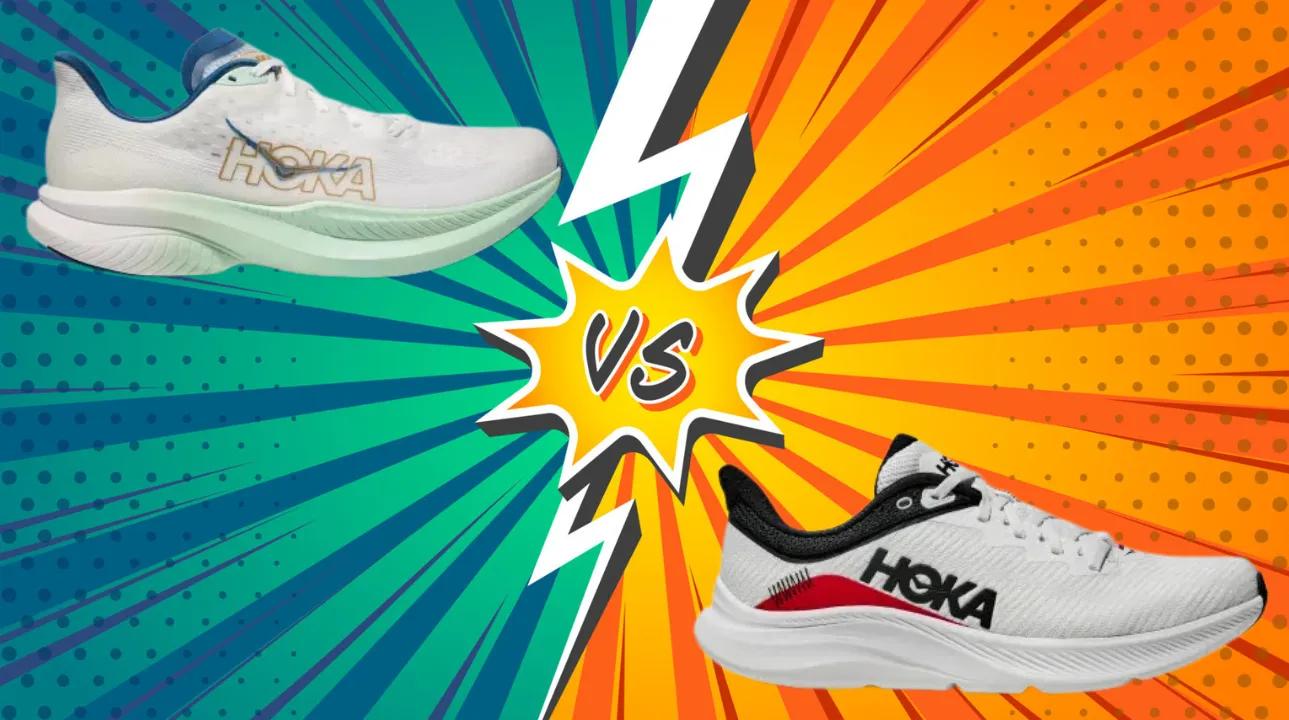Lace up and get ready for an exciting showdown between two of Hoka’s popular running shoes: the Mach 6 and the Solimar. Whether you’re a seasoned marathoner or a casual jogger, choosing the right shoe can make all the difference in your performance and comfort.
In this in-depth comparison, we’ll put these two models through their paces, examining everything from materials to performance. By the end, you’ll have a clear picture of which shoe might be your perfect running companion.
Key Takeaways:
- The Hoka Mach 6 excels in speed and responsiveness, making it ideal for faster runs and races. Its supercritical foam midsole offers a firmer, more energetic feel compared to the Solimar.
- The Hoka Solimar prioritizes comfort and eco-friendliness, featuring recycled materials in its construction. It’s better suited for daily training runs and those who prefer a softer, more cushioned ride.
- Both shoes offer neutral stability, but the Mach 6’s lower profile provides a more ground-connected feel. The Solimar’s Meta-Rocker design aids in smooth heel-to-toe transitions during runs.
- The Mach 6 is slightly lighter and has a lower heel-to-toe drop (5mm vs 6mm), which may appeal to runners seeking a more natural foot strike and agile performance.
- While the Mach 6 is pricier at $140, it offers versatility for both training and racing. The Solimar, at $125, provides excellent value for those primarily focused on comfortable daily training.
Comparison Table between Hoka Mach 6 And Hoka Solimar:
| Feature | Hoka Mach 6 | Hoka Solimar |
|---|---|---|
| Launched In | 2023 | 2023 |
| Stability | Neutral | Neutral |
| Flexibility | Moderate | Moderate |
| Sizing | True to size | True to size |
| Weight | 8.20 oz | 8.50 oz |
| Cushion | Responsive to Balanced | Responsive to Balanced |
| Outsole | Strategic rubber coverage | High abrasion rubber |
| Midsole | Supercritical foam | Compression-molded EVA foam |
| Upper | Creel jacquard | Recycled content mesh |
| Retail Price | $140 | $125 |
Features Comparison:
1) MATERIAL: outsole, insole, upper sole
The Hoka Mach 6 and Solimar showcase different approaches to material selection, each with its own merits. The Mach 6 features a strategic rubber outsole coverage, providing durability in high-wear areas while keeping the overall weight down.
Its supercritical foam midsole offers a responsive and light ride. The upper is constructed with a Creel jacquard material, known for its breathability and support.
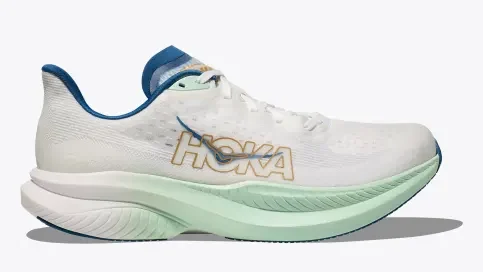
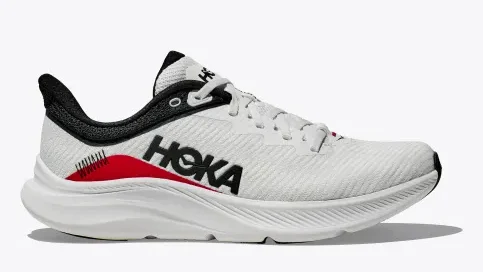
In contrast, the Solimar boasts a high abrasion rubber outsole, suggesting enhanced durability for varied terrains. Its midsole utilizes compression-molded EVA foam, a tried-and-true material known for its cushioning properties.
The Solimar’s upper is made from stretchy, recycled content mesh with 88% recycled polyester, appealing to environmentally conscious runners. Both shoes incorporate molded EVA sockliners for added comfort and support.
2) Durability:
When it comes to durability, both the Mach 6 and Solimar are built to last, but they approach longevity in different ways. The Mach 6’s strategic rubber placement on the outsole targets high-wear areas,
Potentially extending the shoe’s lifespan while maintaining a lighter weight. Its Creel jacquard upper is designed to withstand the rigors of daily running while providing necessary flexibility.
The Solimar, with its high abrasion rubber outsole, may have a slight edge in overall durability, especially for runners who frequently tackle rougher surfaces. Its recycled content mesh upper, while eco-friendly, is also engineered to be resilient.
Both shoes should hold up well under normal running conditions, but the Solimar might have a slight advantage for those who are particularly hard on their shoes or run on more challenging terrain.
3) Fit:
Fit is crucial for comfort and performance, and both the Mach 6 and Solimar offer unique fitting experiences. The Mach 6 features a streamlined collar foam package and a dual internal gusset,
Which work together to provide a secure, comfortable fit around the ankle and midfoot. Its anatomical tongue design further enhances the overall fit and comfort.
The Solimar takes a different approach with its anatomical Achilles construction, which is designed to reduce pressure on the Achilles tendon and provide a more natural fit. It also includes an extended heel pull for easy on and off.
Both shoes are reported to fit true to size, but the Mach 6 might offer a slightly more locked-down feel due to its gusseted tongue, while the Solimar could provide a more accommodating fit for those with wider feet or who prefer a bit more room.
4) Cushioning:
Cushioning is where these two shoes start to show their distinct personalities. The Mach 6 employs a supercritical foam midsole, which is known for its responsive and energetic feel.
This foam is designed to provide a firmer, more efficient push-off, making it ideal for faster-paced runs and races. The cushioning in the Mach 6 is described as low-profile, keeping your foot closer to the ground for better feel and responsiveness.
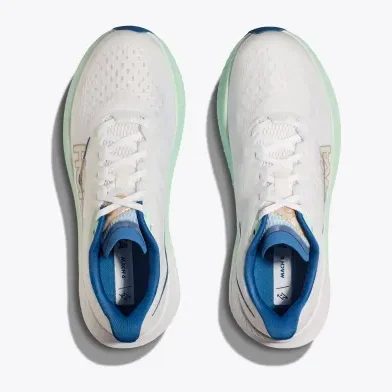
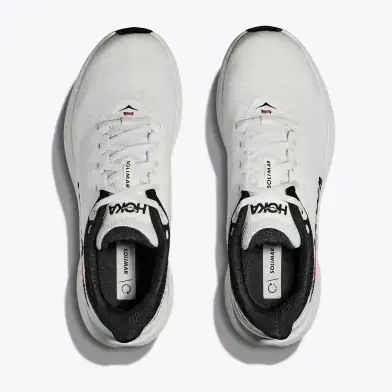
On the other hand, the Solimar uses compression-molded EVA foam in its midsole. This material is known for its reliable cushioning and ability to absorb impact. The Solimar is designed to offer protective cushioning while still maintaining a responsive toe-off.
It’s likely to provide a slightly softer, more traditional cushioned feel compared to the Mach 6. Both shoes fall in the responsive to balanced range on Hoka’s cushion scale, but the Mach 6 leans more towards responsiveness, while the Solimar might offer a touch more plushness.
5) Stability:
In terms of stability, both the Mach 6 and Solimar are classified as neutral shoes, meaning they don’t have additional prescriptive technologies to correct overpronation. However, they approach stability in slightly different ways.
The Mach 6’s lower profile design, with a heel-to-toe drop of 5mm, inherently provides a stable platform. Its firmer midsole material also contributes to overall stability, especially during faster runs.
The Solimar, with a slightly higher 6mm drop, incorporates a late stage Meta-Rocker design. This feature is intended to provide a smooth transition from heel to toe and can contribute to overall stability, particularly during the later stages of your stride.
While both shoes aim to provide the support you need without unnecessary additions, runners who prefer a more ground-feel stability might lean towards the Mach 6, while those who appreciate a guided heel-to-toe transition might prefer the Solimar.
6) Value For Money:
When considering value for money, it’s essential to look at both the initial cost and the long-term value each shoe provides. The Mach 6, priced at $140, is the more expensive option of the two.
However, it justifies its higher price tag with its race-ready design, supercritical foam technology, and versatility for both daily training and competition.
The Solimar, at $125, offers a more budget-friendly option without significantly compromising on quality or features. Its use of recycled materials in the upper and laces adds value for environmentally conscious consumers.
The Solimar’s design seems more focused on everyday training, which could make it a better value for runners who aren’t looking for a race-day shoe.
Ultimately, the better value depends on your specific needs. If you’re looking for a do-it-all shoe that can handle both training and racing, the extra $15 for the Mach 6 might be worth it.
If you primarily need a reliable daily trainer and appreciate eco-friendly materials, the Solimar offers excellent value at its lower price point.
Performance Comparison:
For Walking:
The Mach 6 offers a bouncy, energetic walking experience with its supercritical foam midsole and lower 5mm drop, promoting a natural foot strike. It’s ideal for brisk walks and those preferring a responsive feel.
The Solimar provides a softer, more cushioned walk with its EVA foam and Meta-Rocker design. Its 6mm drop and smoother heel-to-toe transition may be more comfortable for all-day wear and those used to traditional walking shoes. Choose based on your preference for responsiveness or plush comfort.
For Running:
The Mach 6 excels in speed-oriented running, thanks to its responsive supercritical foam and lighter weight (8.20 oz). It’s perfect for tempo runs, intervals, and races, offering a firmer, ground-connected feel. The Solimar, slightly heavier at 8.50 oz, focuses on comfort and versatility.
Its EVA foam midsole and Meta-Rocker design suit longer, slower-paced runs, maintaining efficiency as fatigue sets in. Choose the Mach 6 for speed and responsiveness, or the Solimar for cushioned comfort in daily training runs.
Standing All Day:
For all-day standing, the Mach 6 offers firm yet responsive cushioning with its supercritical foam. Its lower profile and secure fit provide stability and prevent irritation.
The Solimar presents a softer feel with EVA foam and promotes natural posture via its Meta-Rocker design. Its anatomical Achilles construction may benefit those with heel discomfort.
The Solimar’s roomier fit could be preferable for feet that swell. Choose based on your preference for firmer support (Mach 6) or softer cushioning (Solimar).
Plantar Fasciitis:
For plantar fasciitis, the Mach 6’s firmer supercritical foam provides supportive stability. Its lower 5mm drop encourages natural foot strike, potentially benefiting some sufferers.
The responsive midsole may promote efficient gait, reducing plantar fascia stress. The Solimar offers softer EVA foam cushioning to absorb impact. Its Meta-Rocker design aids smooth transitions, potentially easing arch strain. The 6mm drop might relieve Achilles tension.
Choose based on whether you prefer firmer support (Mach 6) or softer cushioning (Solimar) for managing plantar fasciitis.
Conclusion:
Choosing between the Hoka Mach 6 and Solimar ultimately comes down to your specific needs and preferences as a runner. The Mach 6 is the go-to choice if you’re looking for a versatile shoe that can handle both daily training and race day performance.
Its responsive cushioning and lighter weight make it ideal for faster-paced runs. On the other hand, the Solimar shines as a comfortable, eco-friendly daily trainer that offers reliable cushioning and support for a variety of running paces.
Consider your running goals, preferred feel underfoot, and budget when making your decision. Both shoes offer excellent Hoka quality, ensuring you’ll be well-supported on your running journey.

